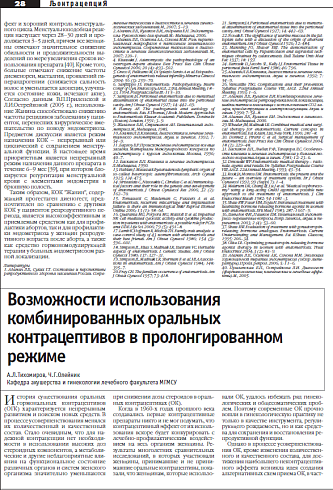Материалы доступны только для специалистов сферы здравоохранения.
Чтобы посмотреть материал полностью
Авторизуйтесь
или зарегистрируйтесь.
Возможности использования комбинированных оральных контрацептивов в пролонгированном режиме
Возможности использования комбинированных оральных контрацептивов в пролонгированном режиме
Материалы доступны только для специалистов сферы здравоохранения.
Чтобы посмотреть материал полностью
Авторизуйтесь
или зарегистрируйтесь.
Полный текст
Список литературы
1. Никитин С.В. К вопросу о современных прогестагенах и комбинированных оральных контрацептивах. Гинекология. 2003; 5 (5).
2. Прилепская В.Н., Куземин А.А., Назарова Н.М. Оральные контрацептивы нового поколения. Гинекология. 1999; 1: 4–5.
3. Серов В.Н., Никитин С.В. Новые возможности лечебного действия комбинированных оральных контрацептивов. Гинекология. 2000; 6 (2): 180–3.
4. Baird DT, Glasier AF. Hormonal contraception. N Eng J Med 1993; 328: 1543–9.
5. Kloosterboer H, Vonk-Noordegraaf CA. Selectivity in progesterone and androgen receptor binding of progestagens used in oral contraceptives. Contraception 1988; 39: 325–32.
6. Kuhl H. Comparative pharmacology of newer progestogens. Drugs 1996; 51 (2): 188–215.
7. Newton JR. Classification and comparison at per oral contraceptives containing new generation progestins. Human Reproduction Update 1995; 3 (1): 231–63.
8. Ruchhoft EA, Elkind-Hirsch KE, Malinak R. Pituitary function is altered during the same cycle in women with polycystic ovary syndrome treated with continuous or cyclic oral contraceptives or a gonadotropin-releasing hormone agonist. Fert Ster 1996; 66 (1): 54–60.
9. Sulak PJ, Kuehl TJ, Ortiz M. Acceptance of altering the standard 21-day/7-day oral contraceptive regimen to delay menses and reduce hormone withdrawal symptoms. Am J Obstet Gynecol 2002; 186: 1142–9.
10. Thomas SL, Ellerstone C. Nuisanceor natural and healthy: should monthly menstruation be optional for women. Lancet 2000; 355: 922–24.
11. Wiegratz, Kuhl H. Long-cycle treatment with oral contraceptives. Drugs 2004; 64 (21): 2447–62.
2. Прилепская В.Н., Куземин А.А., Назарова Н.М. Оральные контрацептивы нового поколения. Гинекология. 1999; 1: 4–5.
3. Серов В.Н., Никитин С.В. Новые возможности лечебного действия комбинированных оральных контрацептивов. Гинекология. 2000; 6 (2): 180–3.
4. Baird DT, Glasier AF. Hormonal contraception. N Eng J Med 1993; 328: 1543–9.
5. Kloosterboer H, Vonk-Noordegraaf CA. Selectivity in progesterone and androgen receptor binding of progestagens used in oral contraceptives. Contraception 1988; 39: 325–32.
6. Kuhl H. Comparative pharmacology of newer progestogens. Drugs 1996; 51 (2): 188–215.
7. Newton JR. Classification and comparison at per oral contraceptives containing new generation progestins. Human Reproduction Update 1995; 3 (1): 231–63.
8. Ruchhoft EA, Elkind-Hirsch KE, Malinak R. Pituitary function is altered during the same cycle in women with polycystic ovary syndrome treated with continuous or cyclic oral contraceptives or a gonadotropin-releasing hormone agonist. Fert Ster 1996; 66 (1): 54–60.
9. Sulak PJ, Kuehl TJ, Ortiz M. Acceptance of altering the standard 21-day/7-day oral contraceptive regimen to delay menses and reduce hormone withdrawal symptoms. Am J Obstet Gynecol 2002; 186: 1142–9.
10. Thomas SL, Ellerstone C. Nuisanceor natural and healthy: should monthly menstruation be optional for women. Lancet 2000; 355: 922–24.
11. Wiegratz, Kuhl H. Long-cycle treatment with oral contraceptives. Drugs 2004; 64 (21): 2447–62.
Авторы
А.Л.Тихомиров, Ч.Г.Олейник
Кафедра акушерства и гинекологии лечебного факультета МГМСУ
Кафедра акушерства и гинекологии лечебного факультета МГМСУ
Цель портала OmniDoctor – предоставление профессиональной информации врачам, провизорам и фармацевтам.

